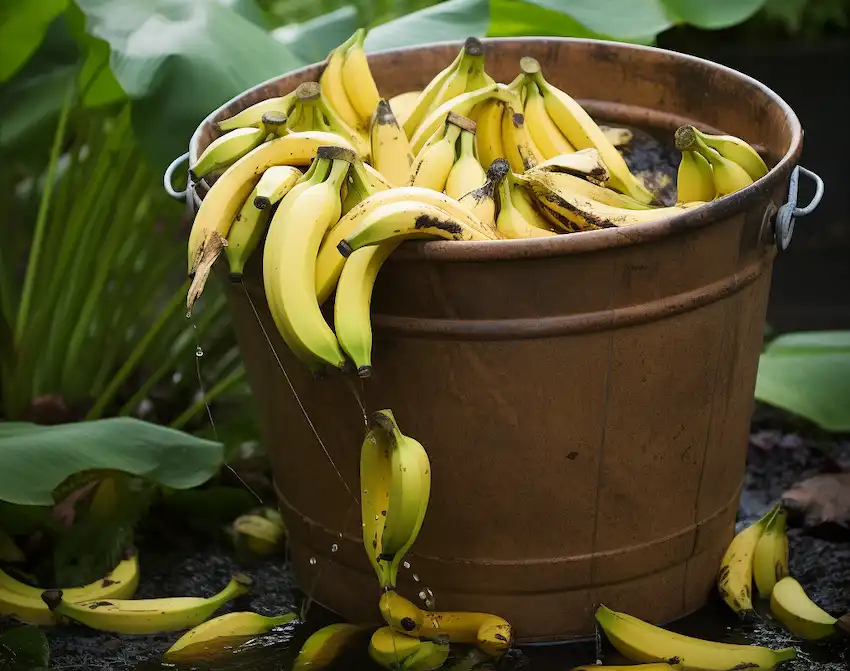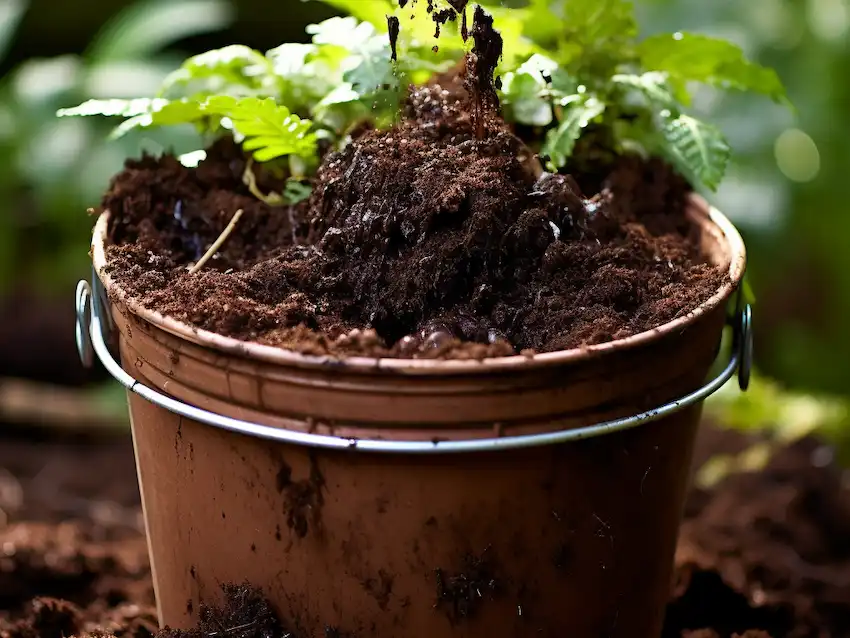Crafting Abundant Harvests: Homemade Fertilizers for Container Potatoes
Unlocking the potential of container-grown potatoes isn’t just about soil and sun—it’s about nurturing them with nature’s own elixirs. Dive into the art of homemade fertilizers, fifteen unique blends meticulously designed to fuel healthy potato growth. From potassium-rich banana peel potions to nutrient-packed vermicompost teas, discover the secrets behind each concoction’s benefits, recipes, and precise application. Elevate your container gardening journey with these handcrafted formulas, each holding the promise of a bountiful harvest in the cozy confines of your own garden.
Homemade Fertilizers for Potatoes in Containers
1. Compost Tea
- Benefit: Rich in nutrients, boosts soil fertility, and encourages beneficial microbial activity.
- How to Make: Mix compost with water in a ratio of 1:5 (compost to water) in a container. Allow it to steep for a few days, stirring occasionally.
- How to Use: Dilute the compost tea with water (1:10 ratio) and apply it directly to the soil around the potato plants.
- Frequency: Apply every 2-3 weeks throughout the growing season.
2. Banana Peel Fertilizer

- Benefit: High in potassium and phosphorus, aiding in root development and flower/fruit production.
- How to Make: Soak banana peels in water for a few days, then strain the liquid.
- How to Use: Dilute the banana peel liquid with water (1:5 ratio) and use it as a soil drench or foliar spray.
- Frequency: Apply every 2-4 weeks during the growth period.
3. Epsom Salt Solution
- Benefit: Supplies magnesium, promoting overall plant growth and enhancing nutrient absorption.
- How to Make: Dissolve 1-2 tablespoons of Epsom salt in a gallon of water.
- How to Use: Water the potato plants with the Epsom salt solution.
- Frequency: Apply every 4-6 weeks during the growing season.
4. Eggshell Powder
- Benefit: Provides calcium to prevent blossom end rot and supports root development.
- How to Make: Crush and grind thoroughly cleaned eggshells into a fine powder.
- How to Use: Sprinkle the eggshell powder around the base of the potato plants.
- Frequency: Apply once at planting and then every 4-6 weeks.
5. Nettle Fertilizer

- Benefit: Rich in nitrogen, stimulates lush foliage growth and overall plant vigor.
- How to Make: Steep nettles in water for a few weeks until the water turns dark.
- How to Use: Dilute the nettle liquid with water (1:10 ratio) and use it to water the plants.
- Frequency: Apply every 3-4 weeks during the growing season.
6. Fish Emulsion
- Benefit: High in nitrogen, promotes leafy growth and overall plant health.
- How to Make: Mix fish scraps with water in a ratio of 1:3 and let it decompose for a few weeks, stirring occasionally.
- How to Use: Dilute the fish emulsion with water (1:5 ratio) and apply it as a soil drench.
- Frequency: Apply every 3-4 weeks during the growing season.
7. Seaweed Fertilizer
- Benefit: Abundant in trace minerals and growth hormones, supports plant growth and stress resistance.
- How to Make: Rinse dried seaweed thoroughly and soak it in water for a few days. Strain the liquid.
- How to Use: Dilute the seaweed liquid with water (1:10 ratio) and use it as a foliar spray or soil drench.
- Frequency: Apply every 2-3 weeks throughout the growth period.
8. Manure Tea
- Benefit: Rich in nutrients like nitrogen, phosphorus, and potassium, enhances soil fertility.
- How to Make: Soak well-aged manure in water for several days to create a concentrated liquid.
- How to Use: Dilute the manure tea with water (1:5 ratio) and apply it around the base of the potato plants.
- Frequency: Apply every 3-4 weeks during the growing season.
9. Coffee Grounds

- Benefit: Contains nitrogen, potassium, and other minerals, helps with soil structure and acidity.
- How to Use: Mix coffee grounds directly into the soil around the potato plants.
- Frequency: Apply once every few weeks, but avoid excessive use due to the potential for acidity buildup.
10. Wood Ash Fertilizer
- Benefit: Provides potassium and helps raise soil pH.
- How to Use: Sprinkle wood ash sparingly around the potato plants.
- Frequency: Apply once during the planting stage and then as needed to maintain soil pH.
11. Vermicompost Tea
- Benefit: Packed with nutrients and beneficial microbes, improves soil structure and plant health.
- How to Make: Steep vermicompost in water for a few days, stirring occasionally.
- How to Use: Dilute the vermicompost tea with water (1:5 ratio) and apply it as a soil drench.
- Frequency: Apply every 2-3 weeks during the growing season.
12. Bone Meal Fertilizer
- Benefit: Rich in phosphorus, supports root development and flowering.
- How to Use: Sprinkle bone meal around the base of the potato plants during planting.
- Frequency: Apply initially during planting, and reapply every 6-8 weeks if needed.
13. Green Tea Fertilizer
- Benefit: Contains antioxidants and nutrients, aids in plant growth and disease resistance.
- How to Make: Brew green tea and allow it to cool to room temperature.
- How to Use: Use the cooled green tea to water the potato plants.
- Frequency: Apply every 3-4 weeks during the growing season.
14. Molasses Solution
- Benefit: Feeds beneficial soil microbes, promotes nutrient uptake, and improves soil structure.
- How to Make: Mix one tablespoon of molasses in a gallon of water.
- How to Use: Water the potato plants with the molasses solution.
- Frequency: Apply every 3-4 weeks throughout the growth period.
15. Grass Clipping Mulch

- Benefit: Adds nutrients to the soil as it decomposes and helps retain soil moisture.
- How to Use: Spread a thin layer of dried grass clippings around the potato plants as mulch.
- Frequency: Apply periodically as needed for moisture retention and soil enrichment.
These homemade fertilizers provide a comprehensive range of nutrients and soil conditioning to support healthy potato growth in containers. Now that we have a collection of 15 different fertilizers, are you ready to discuss combining them and their optimal usage for the potato growing season?
Seasonal Fertilizer Combination for Potatoes in Containers
Early Growth Stage (Planting):
- Eggshell Powder: Sprinkle around the base of the plants for initial calcium support.
- Bone Meal: Incorporate into the soil during planting for phosphorus and root development.

Vegetative Growth Stage:
- Compost Tea: Apply alternately with other liquid fertilizers (fish emulsion, seaweed fertilizer, vermicompost tea) every 2-3 weeks to boost overall plant health and nutrient uptake.
- Nettle Fertilizer: Use as a foliar spray or soil drench for a nitrogen boost, especially during the vegetative phase.
Flowering and Tuber Formation:
- Banana Peel Fertilizer: Apply to encourage flower and tuber formation due to its high potassium content.
- Manure Tea: Introduce to sustain soil fertility and provide a balanced nutrient profile for tuber development.
Overall Maintenance:
- Coffee Grounds: Periodically mix into the soil for continued organic matter and mineral supply.
- Wood Ash Fertilizer: Use sparingly to maintain soil pH and supplement potassium.
Additional Boosts (Optional):
- Seaweed Fertilizer: Apply during stressful periods or as a boost for overall growth.
- Green Tea Fertilizer: Use as a supplement for antioxidants and additional nutrients.
By using a combination of these fertilizers strategically throughout the growth stages, you’ll provide the potato plants with a diverse array of nutrients and support their different growth phases.
It’s important to observe the plants for signs of deficiency or excess and adjust the fertilization schedule accordingly. Always remember, moderation is key, and excessive fertilization can harm the plants. Additionally, these suggestions can be tailored based on specific soil conditions, climate, and individual plant needs.

As you nurture your container garden of flourishing potatoes, remember that the magic lies not just in the harvest but in the journey—infusing your gardening with the art of homemade fertilizers adds a touch of craftsmanship to nature’s canvas. Armed with these organic blends, you’ve unlocked the door to a world where each carefully concocted potion breathes life into your plants, promising not just healthy growth but a flavorful yield. Embrace the alchemy of homemade fertilizers, and may your future harvests be as abundant as the care you’ve invested in crafting them.



















